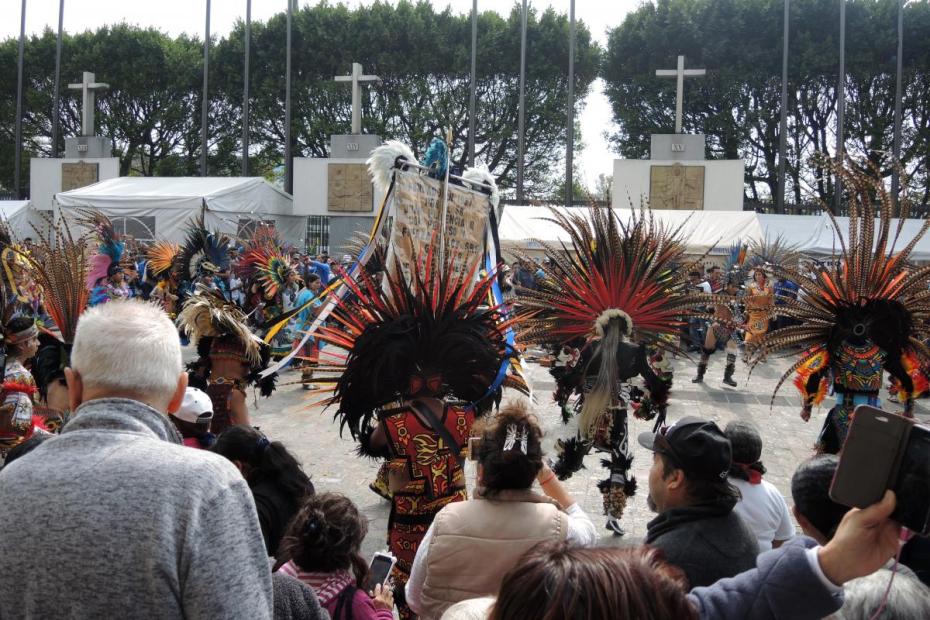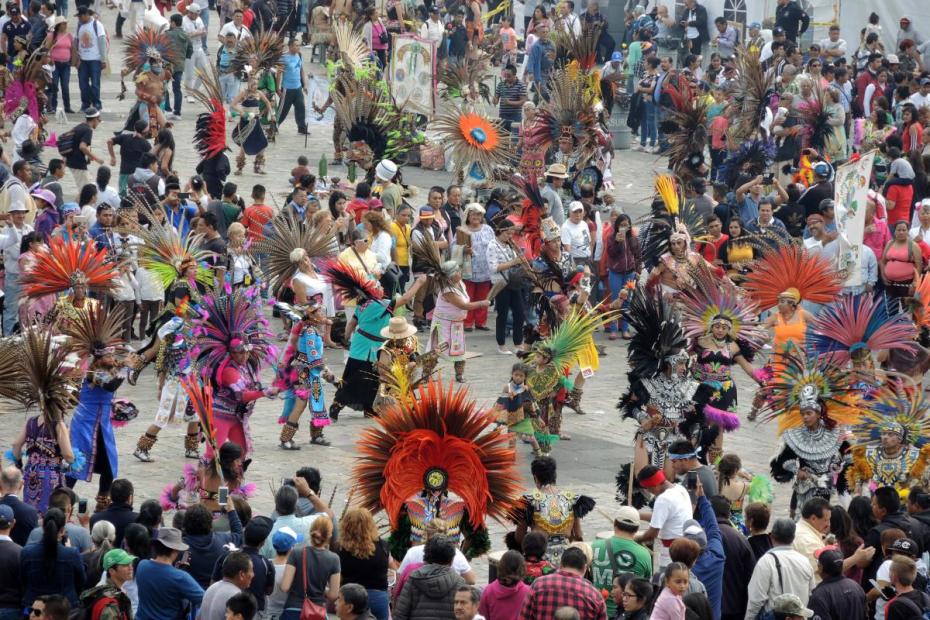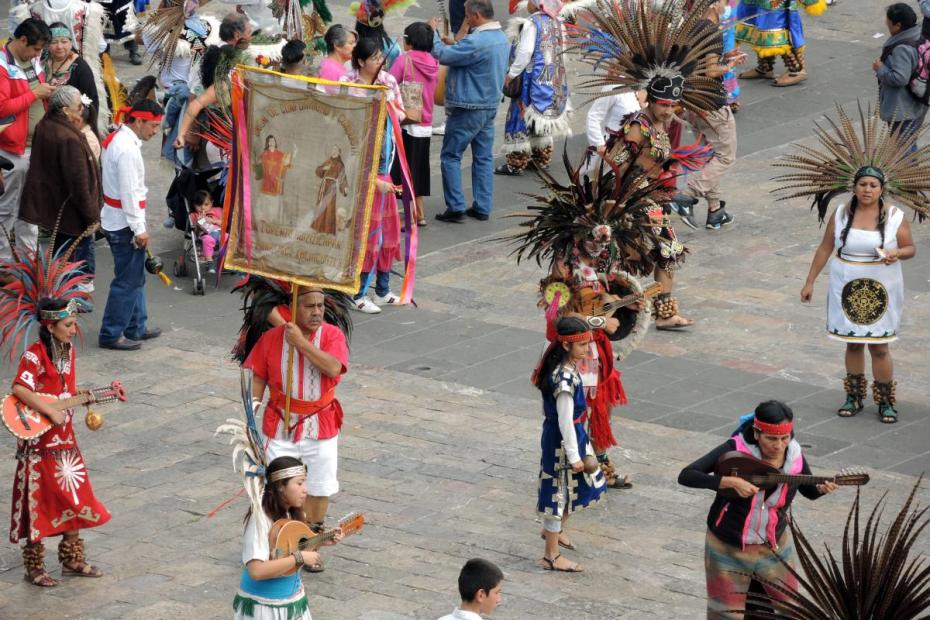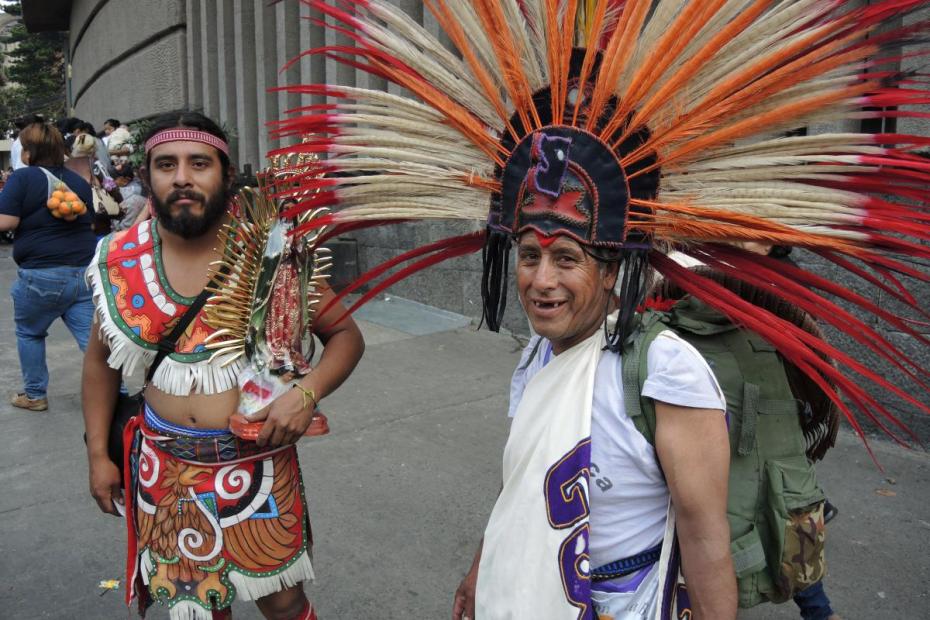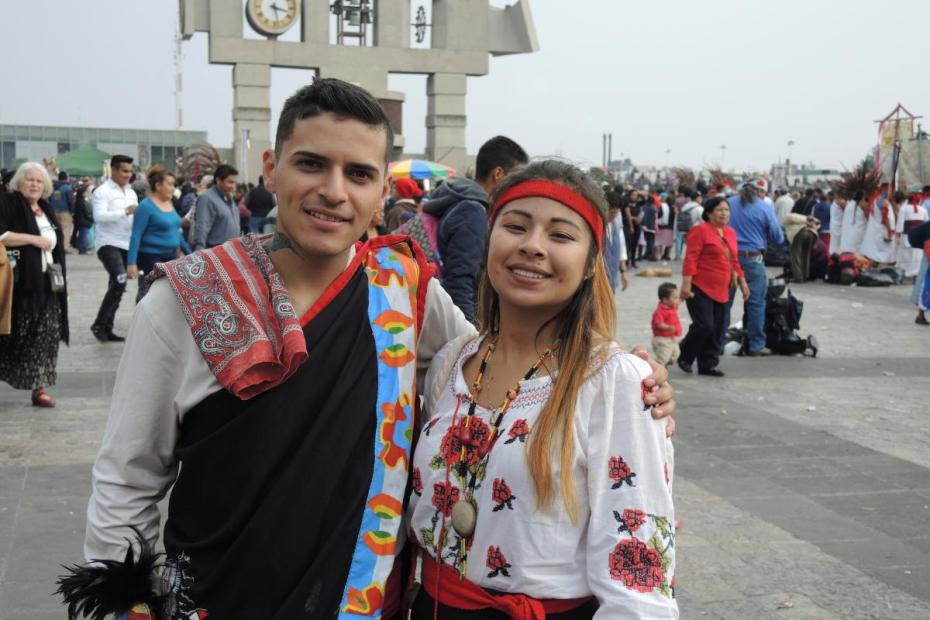During the days leading up to the feast of Our Lady of Guadalupe, and on the feast itself, the vast plaza in front of the Basilica of Our Lady of Guadalupe in Mexico City is filled with many powerfully compelling sights—the endless stream of pilgrims stopping to pray with heartfelt fervor outside the door of their Mother’s home; the thousands of campers who mark out a spot to sleep overnight on the upper reaches of the plaza; the hundreds of household statues and paintings of Guadalupe carried on the backs or in the arms of devotees who may have walked for days; the occasional penitent crossing the plaza on his knees; the flowers some people carry to lay before her. Compared to Guadalupe’s calm image, the varieties of quiet, expressive devotion that pilgrims embody as they approach the shrine or walk the grounds, and the liturgical formality that predominates inside the basilica, another sight can seem particularly incongruous—the sight of hundreds of dancers, many in feathered headdresses and indigenous-style costume, dancing vigorously in various parts of the plaza.
The thunderous sounds of the drums that accompany the dancers are constant throughout these days, audible even in the basilica, emanating from all over the plaza. To unseasoned eyes, the raucous music and dance could appear to be a sort of competition to, rather than participation in, the devotion to Guadalupe—a kind of pre- or post-Christian commitment to indigenous, non-Christian religion. In fact, it is a form of devotion to Guadalupe with mixed Iberian and indigenous roots, organized very much as a form of prayer, though its meaning to the dancers is undoubtedly multilayered.
The dancers in the plaza perform a variety of dances derived from several areas of central and southern Mexico. The most frequently represented, and most prominent type of dancers, easily identifiable by their huge plumed headdresses, are known as Concheros, a name that derives from the stringed instrument whose body is made from an armadillo shell. Along with the drums, and rattles carried or fitted to dancers’ ankles, it provides the soundtrack for their dances.
Turning the expected conventions for prayer upside down, one senior Conchero told me, “The way people pray inside, standing and kneeling, is another way of praying the way we pray here in the plaza.”1
Dancing in the plaza is not a casual experience, or a one-off effort. The dancers belong to autonomous groups known as mesas, each led be a jefe or chief. They meet often to dance and to rehearse.2 Members are typically expected to dance at least four times a year, including at major feasts at Los Remedios and Chalma, and occasionally at a velación, an all-night vigil held nine days after a death.3 Each mesa is dedicated to Christ, or Guadalupe, or San Juan Diego, or some other saint, who is pictured on a the European-style processional banner that is carried to dance. Initiation into a mesa entails a pledge to God and one’s ancestors to uphold the dance for life, “until God cuts off their steps,” as one dancer reported, though in reality many dancers do apparently move between mesas over the course of their lives.4
The dance, and the indigenous costume, make particular sense when we recall that the revelation of Guadalupe was to an indigenous Nahuatl man who brought word of her—and her image—to the Spaniards, rather than vice-versa. The staff of the basilica makes sure that the idea that all Mexicans, including the variety of indigenous, mestizo (mixed race), and European-origin people from throughout the country, are visibly depicted as being drawn together toward and by Guadalupe.
Still, the dancers can seem incongruous not simply because of their sound and energy, but because they are not spatially oriented in the direction of San Juan Diego’s tilma, the famous image of the Virgin above the altar that pilgrims come to venerate. Inside the basilica, where they were often welcomed down the center aisle or around the altar, costumed representatives of indigenous groups were easy to comprehend. Outside, as the stream of pilgrims moves past them going towards the basilica, the dancers form alternative, and long-lasting, centers of attention.
Though it is deliberately located in the basilica’s Plaza Mariana, Conchero dancing is quite differently-oriented spatially. Dancers orient themselves to the “four winds” of pre-Christian understanding, and often move around a small tableau set up with incense and images of Guadalupe. The dance takes place under the cloth banner of the group, one very much like that seen in other Iberian processional and liturgical contexts. This banner is a sacred object, not incidental, said to provide a “shadow” whose spiritual protection “covers the group from the moment [it] is raised.”5
The ritual of the dance typically begins the evening before. Both vigil and dance last many hours. A nighttime vigil, generally in a home, a ritual of preparation and cleansing for the dancers, is marked by prayers, albanzas (religious hymns) and the creation of a sacred image. An altar with flowers, candles and images and even secular objects is set up. Food is shared. The prayers are typical Catholic prayers like the Hail Mary and the Lord’s Prayer, but also evoke the saints and the animas the souls of their ancestors, and the four winds. Flowers and candles are used to make a cross on the floor.6
At the basilica, some dancers entered the church for a permiso, an act “to gain consent from God and the Virgin,”7 but most seemed to do so just in front of the new basilica. They lined up to create an aisle for their members, who approached one at a time, often kneeling and blessing themselves, or pacing forward and back, praying and holding flowers, toward the tilma image inside.
Then, elsewhere in the plaza, they set up columns to orient to the four winds and to cleanse and mark the space where they would dance. They set up the incense and the Guadalupe images and dance at the direction of the jefe for hours, perhaps with a break to eat. The dancers often played their own stringed instruments. They danced in a coordinated, though not uniform, way.
Small audiences gathered around the dancers. Some of the groups tried to discourage photography, fearing that it would commodify the event. After hours of strenuous dance, they typically sing the Guadalupana and ask permission to take leave.8
Concheros and other groups dance in devotion to Our Lady of Guadalupe the days before and day of her feast.
A long history of dance, often interrupted and reconstituted
While the whole history of the dance in the plaza cannot be traced here, and we have mostly images and the oral traditions of the mesas to rely on, it is worth noting that the tradition of dancing for Guadalupe in the basilica’s plaza is as old as the Guadalupe devotion itself.9 In the first written account of the story of the apparition, Fr. Miguel Sánchez recounts that Indian dances accompanied the translation of the image from the cathedral to the new chapel at Tepeyac, on December 26, 1531.10 In a grand 1709 painting of the transfer of the famous Guadalupe canvas to the then-new basilica church, a large section of the plaza is taken up by groups of dancers, dancing much like those today while the solemn, formal procession of clergy and dignitaries carried the famous image of Our Lady of Guadalupe through the center of the plaza. The juxtaposition in that painting is as marked as it is today. The dance was a longstanding factor in Catholic life, but not always welcome. “Although… indigenous communities had continued to co-opt popular festivals to assert their agenda and ‘ethnic royalty,’ these rituals were viewed [by colonial elites] as a threat to proper decorum.”11
The dances in the plaza today are not the same ones pictured even in 1709, not least because many are forms imported by devotees from other parts of Mexico. Nor can they entirely be labeled as indigenous, rather than Spanish. Some elements were imported or created by Spaniards. The dances were also forbidden in public by anti-clerical regimes in the 19th and 20th century. Dancers can trace their tradition back a long time, but it is also clear that they dance continually recreated versions of the dance, and the structure of the organizations gives them the ability to recreate it.12
In the last 50 years, some of the dancers have tried to re-indigenize the dances to varying degrees, dropping away Spanish elements and creating new styles of dress by borrowing from pre-colonial images. Other dancers, known as Mexica dancers, have formed groups that emphasize only the indigenous elements of the dance, cutting out the Spanish and Christian elements. Mexica dancers can be seen daily in places like Mexico City’s Zocalo, but did not seem to be present at Guadalupe. Their project is primarily a matter of identity politics, and Conchera dancers don’t like what they are doing to the dance.13 Still, the movement has impacted the Conchera dance. Younger dancers prefer the less full-clothed forms of dress favored by Mexica dancers, and often want the more exciting and individualized dance styles they see among Mexica.14
The meaning of the dance
The Concheros dancers at the basilica certainly dance for many reasons. From all that was observable in the plaza, they fit the profile of the most traditional, Catholic groups, not of the Mexica. They carried Catholic standards, and organized themselves around images of Guadalupe. A number of dancers, but not all, were happy to be interviewed. Those who did not want it did not want to be distracted from their purpose, or suggested that the experience would be diminished by explanation. One interviewee, a man in his early twenties, said that he had danced for 19 years, under the leadership of his father. His new wife was dancing here with him for the first time, and he liked that the mesas brought in new people to keep up the tradition.
Susannah Rostas, who studied several concheras groups more intimately and over a long period of time, found that people, even dancers, she got to know well had difficulty putting the experience into words, or don’t want to.15 Her interviewees said they danced to honor Guadalupe, including as a promesa (a request for a favor matched by a promise to come back and do something in return) to her, out of gratitude for having had help putting their lives back together after a difficulty, to link to their roots, to find themselves in a community. Some, usually urban dancers, she concluded, “conceive of it as a search for states of being beyond those of the everyday.”16 She also reported that for many of the dances she participated in, dancers participated “from a sense of obligation as much as commitment,” a sense of responsibility to keep the dance alive.17 She concludes, “There is no one dogma” to the dance: the metaphors deployed resonate differently for each” dancer and viewer. “What matters to the dancers most is the experience of participating rather than speculating as to what each dance means.”18
Read more
Susannah Rostas, Carrying the Word: The Concheros Dance in Mexico City (University of Colorado, 2009).
- 1This research was based on observations and interviews with four Conchero dancers during the Mañanita and feast of our Lady of Guadalupe, Dec. 11-12, 2018, and was fortified, as is noted throughout, by Susannah Rostas’ excellent monograph, Carrying the Word: The Concheros Dance in Mexico City (University of Colorado Press, 2009).
- 2There are associations of mesas, but each mesa is largely autonomous. Beneath the jefe, the organization is conceived in military terms, with captains, lieutenants and soldiers. More traditional members, Rostas reports, describe themselves as soldiers for Christ. Rostas, 21-22.
- 3Rostas, 1, 25. Chalma is arguably Mexico’s second largest Catholic pilgrimage site. Los Remedios, another Marian site, is in Mexico City. The third site is Amecameca. Rostas refers the Guadalupe site by one of its geographical names, La Villa, and reports that “The dance at La Villa is the largest and possibly the most important” site. Rostas, 25.
- 4Rostas, 32.
- 5Rostas, 91.
- 6I was not able to observe this, and only heard such preparations obliquely referenced by interviewees. This description comes from Rostas, 43-55.
- 7Rostas, 58.
- 8Rostas 59-62.
- 9Rostas on oral traditions.
- 10Fr. Miguel Sánchez, Image of the Virgin Mary, Mother of God of Guadalupe, Miraculously appeared in Mexico City 1648, as cited in Stafford Poole, C.M., Our Lady of Guadalupe: The Origins and Sources of a Mexican National Symbol, 1531–1797 (University of Arizona, 1995), 103. We should also be careful to note that the Sánchez account appears a century after the events it describes, but have no reason to doubt the veracity of that claim about dancing.
- 11Jeanette Favrot Peterson, Visualizing Guadalupe: From Black Madonna to Queen of the Americas (Austin: University of Texas, 2014), 253. The analysis of the painting derives from Peterson, 239-255.
- 12Rostas (167) reports that even in the oral history of the mesas, there are debates whether the dances owe origin to pre-Columbian roots, or to Iberian Franciscans.
- 13Rostas, 191-209.
- 14Rostas deals with these extensively, and argues that except for the impact that can be seen in terms of costume and style, Mexica and Conchero dancers are two different things.
- 15Rostas, 4.
- 16Rostas, 8.
- 17Rostas, 2.
- 18Rostas, 3.
